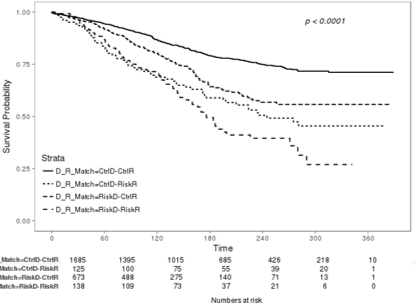The Impact of Age-Matching on Graft Function and Graft Survival after Living Donor Kidney Transplantation
1Department of Surgery, Yonsei University College of Medicine, Seoul, Republic of Korea
2Department of Surgery, Ewha Womans University, School of Medicine, Seoul, Republic of Korea
3Department of Surgery, CHA Bundang Medical Center, CHA University, Seongnam, Republic of Korea
4Department of Internal Medicine, Yonsei University College of Medicine, Seoul, Republic of Korea.
Meeting: 2018 American Transplant Congress
Abstract number: 51
Keywords: Age factors
Session Information
Session Name: Concurrent Session: Kidney Living Donor: Selection
Session Type: Concurrent Session
Date: Sunday, June 3, 2018
Session Time: 2:30pm-4:00pm
 Presentation Time: 3:18pm-3:30pm
Presentation Time: 3:18pm-3:30pm
Location: Room 606/607
Introduction: To overcome the shortage of organs, the influence of age matching in living donor kidney transplantation should be studied. We analyzed the impact of age-matching on outcome after LDKT. Method: The data of 2621 recipients who underwent LDKT were reviewed. Patients were divided into four groups according to the cutoff values of donor age 45 years and recipient age 25 years; CtrlD-CtrlR, CtrlD-RiskR, RiskD-CtrlR, and RiskD-RiskR. The renal function, the total graft survival and the death censored graft survival were compared among the groups. Result: At 1, 3, 5, 15, and 20 years after transplant, the eGFR of recipients from control donor was significantly higher than that of recipients from risk donor regardless of recipient age group (Control recipients, P<0.001; Risk recipients, P=0.005). When we compare the death censored graft survival rate for 20 years, CtrlD-CtrlR showed the highest survival rate and RiskD-RiskR showed the worst survival rate (P<0.001). In multivariate analysis, pretransplant dialysis, acute rejection within 1 year and age group were the independent risk factor for death censored graft survival.
Conclusion: The younger living donors provide the best outcomes for recipients regardless of the age. For elderly recipients, the next best alternative option is receiving old living kidneys rather than dialysis or DDKT.
CITATION INFORMATION: Lee J., Kim D., Lee J., Lee J., Jung Y., Ju M., Song S., Lee J., Huh K., Kim B., Kim S., Kim Y., Kim M. The Impact of Age-Matching on Graft Function and Graft Survival after Living Donor Kidney Transplantation Am J Transplant. 2017;17 (suppl 3).
To cite this abstract in AMA style:
Lee J, Kim D, Lee J, Lee J, Jung Y, Ju M, Song S, Lee J, Huh K, Kim B, Kim S, Kim Y, Kim M. The Impact of Age-Matching on Graft Function and Graft Survival after Living Donor Kidney Transplantation [abstract]. https://atcmeetingabstracts.com/abstract/the-impact-of-age-matching-on-graft-function-and-graft-survival-after-living-donor-kidney-transplantation/. Accessed December 19, 2025.« Back to 2018 American Transplant Congress


